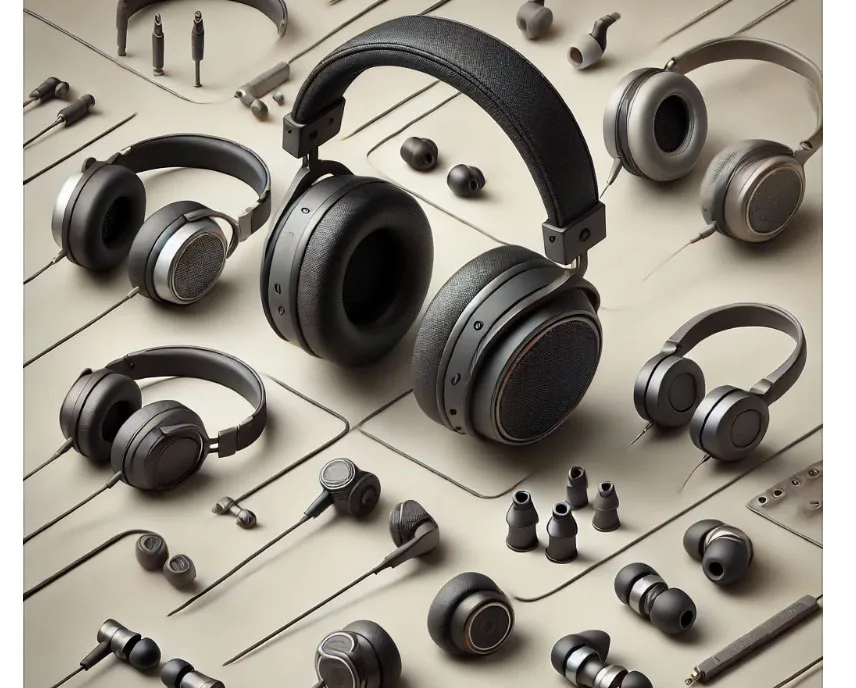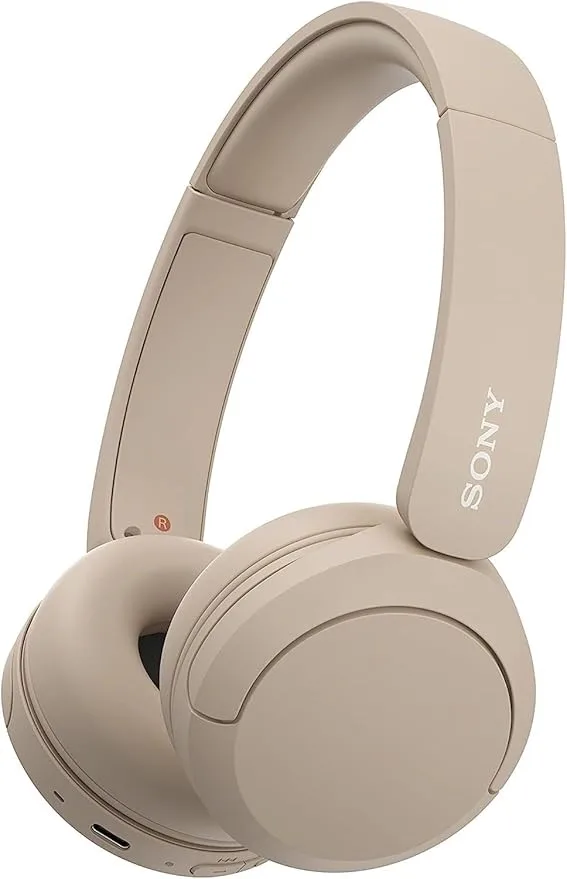Key factors to consider when choosing the right type of headphones for your lifestyle.
Choosing the right headphones can be overwhelming, with so many options catering to various needs and preferences. Whether you’re looking for headphones to use during workouts, on your commute, or at home for high-quality audio experiences, the decision ultimately depends on your specific use case, budget, and personal comfort.
1. Types of Headphones
There are three main categories of headphones: over-ear, on-ear, and in-ear. Each of these types has its own unique features that affect sound quality, portability, and comfort.
Over-Ear Headphones
Over-ear headphones (circumaural) have large ear cups that completely cover the ears, offering the best sound quality and noise isolation. These headphones provide a more immersive listening experience, ideal for audiophiles and professionals who require high-quality sound.
- Pros: Excellent sound quality, good passive noise isolation, and comfortable for long listening sessions.
- Cons: Bulky, less portable, and can cause heat buildup around the ears during extended use.

On-Ear Headphones
On-ear headphones (supra-aural) sit on top of the ears rather than enclosing them. These headphones are generally lighter and more portable than over-ear models, making them great for commuting or casual use.
- Pros: Lightweight, portable, and more breathable than over-ear headphones.
- Cons: Less sound isolation and can become uncomfortable with prolonged use.
In-Ear Headphones
In-ear headphones, also known as earbuds, are inserted directly into the ear canal. They are highly portable and often come with various tips to fit different ear shapes. Many in-ear models now come with wireless capabilities, making them perfect for activities like running or commuting.
- Pros: Extremely portable, good noise isolation, and increasingly wireless.
- Cons: Can be uncomfortable for some users, and sound quality is generally not as rich as larger headphones.
2. Wired vs. Wireless Headphones
Another important consideration is whether you prefer wired or wireless headphones. Each option has its own advantages and disadvantages.
Wired Headphones
Wired headphones are connected to your device via a cable. They provide superior sound quality because the signal doesn’t experience any loss or compression like with wireless connections.
- Pros: Better sound quality, no need to charge, and more affordable.
- Cons: The cable can be restrictive, limiting your movement and causing tangling issues.
Wireless Headphones
Wireless headphones, using Bluetooth or other wireless technologies, provide more freedom of movement and have become very popular, especially for outdoor activities and commuting. Most modern wireless headphones also offer excellent sound quality, though they might not match the precision of high-end wired models.
- Pros: Freedom of movement, no tangling cables, and more convenient for activities like exercising.
- Cons: Need to be charged regularly, and sound quality may not be as good as wired options.
3. Open-Back vs. Closed-Back Headphones
Understanding the difference between open-back and closed-back headphones can help narrow down your options based on your listening environment.
Open-Back Headphones
Open-back headphones have ear cups with perforations or grills that allow air and sound to pass through. This creates a more natural and airy sound, simulating the experience of listening to speakers in a room. However, open-back headphones allow external noise to enter and also leak sound, making them unsuitable for public or noisy environments.
- Pros: Spacious, natural sound, ideal for critical listening in quiet environments.
- Cons: Poor noise isolation and significant sound leakage.
Closed-Back Headphones
Closed-back headphones have sealed ear cups that block external sound and prevent sound leakage. This makes them ideal for commuting, travelling, or use in noisy environments, where you want to focus solely on your music or podcast without disturbances.
- Pros: Excellent noise isolation, no sound leakage, and enhanced bass response.
- Cons: Can feel less natural and immersive, and some users may experience ear fatigue after extended use.
4. Noise-Canceling vs. Noise-Isolating Headphones
When selecting headphones, you may also want to decide between noise-cancelling and noise-isolating headphones, particularly if you plan to use them in noisy environments.
Noise-Canceling Headphones
Noise-cancelling headphones use active noise control (ANC) technology to block out external noise. They generate sound waves that cancel out ambient sounds, making them perfect for use in noisy environments such as aeroplanes or busy offices. However, they require power (typically via battery), which can affect the weight and price of the headphones.
- Pros: Actively reduces ambient noise, ideal for travel and noisy spaces.
- Cons: Requires charging, can be more expensive, and may cause slight ear pressure for some users.
Noise-Isolating Headphones
Noise-isolating headphones rely on passive isolation, which means they physically block out sound by creating a seal around or inside your ears. They do not use any electronic components to cancel noise, but good designs can still effectively reduce outside sounds.
- Pros: No battery required, and often more affordable than noise-cancelling models.
- Cons: Less effective at reducing low-frequency noises (like aeroplane engines), and comfort depends heavily on fit.
5. Purpose and Environment
The way you plan to use your headphones should heavily influence your decision. Here’s a quick breakdown of which types of headphones work best in different situations:
Commuting and Traveling
For daily commuters or frequent travellers, noise-cancelling headphones or wireless in-ear models with good passive noise isolation are ideal. They block out external noise, offer comfort during long rides, and provide freedom of movement.
Exercise and Sports
For active users, lightweight, sweat-resistant wireless in-ear headphones are the best choice. Wireless models with a secure fit, like those with ear hooks or wingtips, ensure they stay in place during vigorous movement.
At Home or Office Use
For home or office use, comfort and sound quality become top priorities. Over-ear or on-ear headphones, whether wired or wireless, offer the best sound experience for music, gaming, or long conference calls. If you work in a noisy environment, consider noise-cancelling models to help you focus.
Professional Audio Work
For audio professionals or serious audiophiles, wired over-ear headphones with an open-back design provide the most accurate and natural sound. Closed-back models can also be useful in studio environments where noise isolation is essential.
6. Comfort and Fit
Comfort is a crucial factor, especially if you plan on using your headphones for extended periods. Here are some key aspects to consider:
- Weight: Lighter headphones are generally more comfortable for long listening sessions, but heavier models often provide better sound quality.
- Padding: Look for headphones with ample padding on the ear cups and headband to reduce pressure on your ears and head.
- Fit: For in-ear models, choose the right ear tip size to ensure a secure and comfortable fit. Poorly fitting in-ear headphones can cause discomfort and diminish sound quality.
7. Budget Considerations
Finally, price is always an important consideration. While premium headphones can offer better sound quality, noise cancellation, and features, there are plenty of budget-friendly options that provide excellent performance. Keep in mind that more expensive doesn’t always mean better, and finding the right balance between quality and price for your specific needs is key.
Budget Headphones
For casual listeners, budget headphones provide decent sound quality without breaking the bank. These are perfect for students, commuters, or those who don’t require high-end features.
Mid-Range Headphones
Mid-range headphones typically offer better build quality, enhanced features like wireless capabilities, and sometimes active noise cancellation. This range is ideal for most users looking for a balance between performance and price.

Premium Headphones
For audiophiles and professionals, premium headphones deliver top-tier sound quality, with advanced features like superior noise cancellation, Hi-Fi sound, and premium materials. These are more of an investment but provide the best listening experience.
Conclusion
We hope this article will help in considering How to Choose the Right Type of Headphones for you. We know choosing the right type of headphones depends on multiple factors such as intended use, comfort, sound quality, and budget. By understanding the different types of headphones and considering how and where you’ll use them, you can make an informed decision that suits your specific needs. Whether you need a compact in-ear model for commuting, high-quality over-ear headphones for professional audio work, or wireless options for the gym, there’s a perfect pair out there for you.